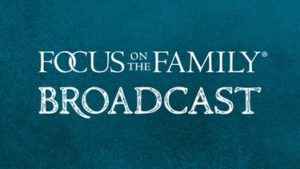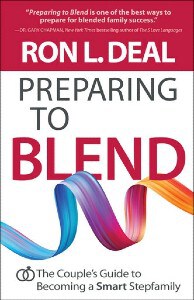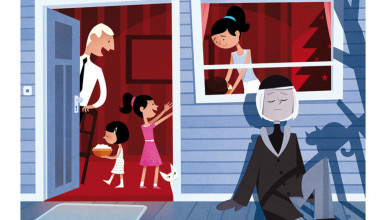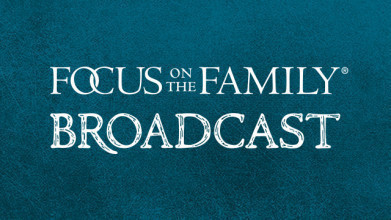John Fuller: I’m John Fuller. And today on Focus on the Family with Jim Daly we’ll be examining life in a stepfamily and specifically what to anticipate if you plan to marry into a stepfamily.
Dramatic teaser
Man: Okay. Let’s go over the family rules again.
Woman: Okay, okay, right. I’m not supposed to say the name Debbie because your uncle’s wife will go into hysterics.
Man: Right?
Woman: Ruth is your step grandmother.
Man: Grandmother.
Woman: But you call her Aunt Ruth?
Man: Aunt Ruth, yeah.
Woman: Okay. Your stepmother prefers Jane.
Man: Oh yeah.
Woman: Not mom or mother.
Man: Yeah.
Woman: Oh, honey, maybe we should just email everyone to say we’re getting married. Man: No, no, no, no. That’s how my brother-in-law told my sister they were getting a divorce. That’s out. No. Okay. Now, don’t worry about it. We’ll go over all this again when we visit my dad’s family.
Woman: Oh, dear.
Jim Daly: John, that sounds really complicated. And I wonder how many couples who are considering remarriage really understand what they’re getting into. And, uh, first time marriages have their challenges too, uh, different expectations, managing conflict, learning how to communicate effectively. Those are all things that married couples struggle with, but for stepfamilies, there’s another whole level of complexity. Uh, factoring in the needs of your kids and step kids, adjusting to different rules for different households in a different moment and the list goes on. Today we want to offer encouragement and practical help to couples who are considering remarriage. And I’m sure if you’re already in a stepfamily, this information will be equally helpful to you. And for the greater Christian community, we need to be aware of the unique challenges these stepfamilies are facing. I- I’m sure many of these families are in your church and in your community.
John: Mm-hmm.
Jim: And a greater sensitivity to their needs and how we can help them will benefit everyone. I know we’re always critical about, you know, divorce and that’s understandable, that’s right in the Christian community, but it does happen. It could happen through the death of a spouse or a divorce and a remarriage. So let’s be there for people to pick up the pieces and live their lives, uh, closely to the Lord in the future.
John: Yeah, and we have an expert coach with us. Ron Deal is back with us. He’s the founder of Smart Stepfamilies and directs the blended family outreach of Family Life Ministries. Ron has authored or co-authored more than 12 books and resources including, um, one title we’ll, uh, learn more about today, it’s called Preparing to Blend: The Couple’s Guide to Becoming a Smart Stepfamily. Stop by our website to get your copy focusonthefamily.com/broadcast or call 1 800, the letter A, and the word FAMILY.
Jim: Ron, welcome back to Focus.
Ron Deal: Guys, it’s always good to be with you.
Jim: (laughs) Good to be here.
Ron Deal: Thanks for having me back.
Jim: Hey, um, you heard that opening, that is kind of the description of a very complex web of relationships that typically are created when, uh, two different families come together in a remarriage situation. Was it a fair representation?
Ron: Yes, it actually, it is. And one of the things that we want pastors who work with couples doing premarital counseling, for example, and the couples themselves to understand is that you’re being born into a complex family situation, lots of ambiguity in terms of the roles and relationships, and the more you know about that stuff, the better you can anticipate it, the smoother your transition will be. The less you know, the more you can get caught in all the little traps.
Jim: And we’re gonna talk about a number of those today to help those families do better for their success.
Ron: Mm-hmm.
Jim: And, uh, you know, to, uh, I think help the children particularly better understand the environment-
Ron: Yes.
Jim: … they’re in. One thing you recommend as a family map with that crazy, uh, matrix, do you really have people sit down and map out all-
Ron: Absolutely.
Jim: … the connections in relationships?
Ron: You know, family therapists have used what we call a genogram for, ah, 70 years. It’s been, uh, something that we use to help people kind of see their entire family on paper. Uh, I got some friends who went and created a digital map that people can go online and do specifically for blended families, Blending.Love. How’s that for a website address?
Jim: Hmm.
Ron: And it’s built right into this book Preparing to Blend because we want people to be able to look down and say, “Okay, we’re not just creating a family with two adults and five kids. You brought three, I have two, we’ve got five plus the two of us that’s… We’re a family of seven.” No, really, as a blended family, there’s at least two generations, probably three generations and often not always, but often two households or three households. And so you start adding up all of those people and you go from 7 to 20 really fast. And the reason you put it down on paper in terms of this digital map is for the first time Jim, some people going through their premarital prep will see the family they are creating. This is really what you’re building.
Jim: (laughs)
Ron: And it’s eye-opening.
Jim: It can be overwhelming.
Ron: It can be overwhelming and it’s eye-opening. And here’s the thing, I would rather them see it before they start than get completely blindsided by that complexity and it cause strife and marital problems after the wedding.
Jim: Yeah. It’s good to hit those issues head on-
Ron: Yes.
Jim: … and the temperaments and the personalities that are gonna be, um, you know, confronting you as a couple, right?
Ron: That’s it.
Jim: Um, you mentioned in the book that, um, it’s kind of unique with the stepfamily because their, their foundation is built out of loss, the breakup of a previous family, uh, because of something, like I said, it could be death of a spouse.
Ron: Yeah.
Jim: Um, or it could be something where that first marriage didn’t survive and there, in that adult is remarrying. Um, in that context, speak to that idea of being born out of loss. How does that impact the relationships and the dynamics of things?
Ron: Yeah. Well, let me just add to that because we do like to say that blended families are born out of loss. And I like to add that they’re born into ambiguity.
Jim: Huh,
Ron: …and that is another form of loss. Ambiguity is, okay what’s my role as a stepparent? I mean, I’ve got an idea. I- I’ve read a book or heard a podcast or something, and I got a sense of that, but the biological parent also has another idea, there’s two definitions of that stepparent’s role. The kids have an idea. Your former spouse has an idea. Um, the kids’ biological parent, if you’re gonna be a stepdad, they’re bio dad, he has an idea of what you should do and not do in the role with his kids. Like there’s just five or six definitions and so right from the get-go, here’s a stepparent trying to figure out what he’s supposed to do.
Jim: Mm-hmm.
Ron: That’s ambiguity and that creates more confusion and, uh, arguments and conflict potentially. And so there’s loss on the front end. And now there’s a sense of loss of we are don’t, we don’t know how to move forward in this new family. All of that gets in the way of bonding.
Jim: You know, some people may not realize I was part of a blended family way back when I was eight years old, my mom had left and divorced my dad. And then she remarried about three years later to Hank. I nicknamed him Hank the tank, ’cause he was a ex-military guy who literally did Saturday morning white glove inspections in our bedroom.
Ron: Wow.
Jim: And you know the, the thing, when I look back on it now, all these years later, I could tell, I knew he loved my mom deeply. You could see it certainly as she was dying of cancer, he was overwhelmed with emotion. He knew what that would mean for him and for their relationship obviously and she died when I was nine. And in that context, I remember him, you know, saying, I just didn’t sign up for all the kids so I’m out of here and he left the day of the funeral. And you know, there was certainly bewilderment with that, I ended up in foster care. But the point, what I’m trying to say is that he really did love her. He didn’t really care about us much and I get it. You know, that wasn’t what he was signing up for, even though that was part of the deal. But even that the expectation of what the marrying spouse, in my case, the mom had and what that relationship would look-
Ron: Yes.
Jim: … like, the kids have some kind of expectation. What is this gonna be? It can be all over the map-
Ron: Mm-hmm.
Jim: … in terms of what you get with a stepparent. And then of course, the stepparent coming into the family and their expectations.
Ron: Jim, you are making-
Jim: (laughs)
Ron: … you’re making a critical point here. And, and I just gotta put words on it because couples and pastors alike have this sense that when they are gonna get married, that they are just creating coupleness, you know, and they’ve fallen in love, and they love each other. Hank loved your mom. There was something there, there was substance. I- I don’t know the depths of it.
Jim: Absolutely. You could see it.
Ron: There was something there and that’s what brought them together. But the reality is you’re not just creating coupleness, you’re trying to create familiness.
Jim: Right.
Ron: And and let me just pause for a second and talk about premarital counseling, because do you realize we have not done any major overhaul in premarital counseling in 60 years. This book Preparing to Blend is the first overhaul that says, look, you’re not just trying to equip couples to be married. You’re trying to help them lead a family and navigate the journey of becoming a family. You might have become a couple, but that does not mean that the stepparent, y- you are a good example, Jim, that the stepparent is got a great bonded relationship that will last a lifetime with the stepchildren. That is something that has to develop on its own accord over time, often well after the wedding has taken place, in fact, it’s five to seven years for average, right?
Jim: Yeah.
Ron: And some families can take a little longer depending on the age of the children and all the circumstances wrapped around that. The point is, if you go into it blind thinking only about becoming a stronger couple, then you get blindsided by the familiness factors, the complexity and the ambiguity and that’s what takes couples down. We’re preventing re-divorce here, that at the end of the day is my heart, preventing re-divorce and another loss for children in particular.
Jim: Yeah, Ron let me, let me have you address this question because it’s out there, y- you know, in the Christian community, we believe in the permanence of marriage-
Ron: I do.
Jim: … in fact, it’s one of the pillars here at Focus and we say it very boldly. So some people in the Christian community can be critical that if you’re addressing this issue of, uh, remarriage in a new blended family, a- and I- I don’t wanna be smug with this, but some, they write us here at Focus after we’re doing a broadcast together, people will write or text us and say, you know, you really shouldn’t cover that because we’re about first marriages and keeping those marriages together. But it’s kind of, to me, it’s the analogy of the lord dealing with the woman caught in adultery, not the same kind of sin, but what he said there is go and send no more.
Ron: Yeah.
Jim: And I- I hear that in what you’re explaining there, our goal, once a family is fractured is how do we put it back together and God’s design for the future of that family. Um, and it may mean the two people remarried different people, right?
Ron: I’m the biggest advocate in the world for first marriages lasting.
Jim: Yeah.
Ron: Because I spend an awful lot of time with people trying to pick up the pieces and find the next level of love and care for their family and for their kids. And it’s harder, it can be done. And again, like I said, God’s grace is so incredible, some people’s second chance is far better than, uh, anything they’ve experienced thus far in their lifetime, going back to their childhood. In other words, God continues to work in relationships in spite of who we are, all you gotta do is read the Old Testament, you’ll find out really nobody, all those heroes of the faith, nobody got it right when it came to their family. Right? And all those dynamics are true still today. So we wanna be truthful about God’s intent and we want to go heavy on mercy for those who are in need of repair or redemption. And let’s not forget that a lot of people find themselves in blended families because of no sin of their own. Maybe somebody else’s sin sometimes. And sometimes it’s due to a death of a spouse that wouldn’t sin at all. And yet we just sort of leave them hanging out there with note guidance and help and support for their family, you know, post being widowed. So we wanna cover all of that-
Jim: Hmm.
Ron: … with a message of yes, truth, marriage needs to last.
Jim: Yeah, and I-
Ron: Tells the right story about God,
Jim: I appreciate that. I just, you know, those are the comments that are made kind of under everybody’s breath, but it’s good to hit it.
Ron: Yes.
Jim: And just get it out there.
Ron: Yes.
Jim: You know, we’re trying to help people do the best they can do in the moment they’re in and that’s where it’s at. Be honest, if we didn’t have a 35, 40% divorce rate in the church, we wouldn’t have to deal with it. So that’s a great place to start, which is a lot of the effort that Focus puts forward.
Ron: Mm-hmm.
Jim: Um, moving on, you have a story about one step couple that you call Aaron and Morgan in the book-
Ron: Mm-hmm.
Jim: And they had kind of those different expectations of what it would be. What was their story?
Ron: Well, you know, o- one of the things that we talk about in this book Preparing to Blend is anticipating the changes that are gonna come and managing your expectations about how life is gonna go after the wedding. Again, if you’re thinking, I’ve fallen in love with a person that’s really all there is. And because you and I are in love, the kids are gonna love that we love each other. Well, sometimes they do and sometimes they don’t, or sometimes they’re a little confused by it. It, often children experience both, um, things. They experience happiness that mom’s getting married and they like the stepdad and there’s something about him that they’re really drawn to. And at the same time, they feel a little weird about drawing into him when their biological dad is on, in somewhere else. And they don’t get to spend as much time with him as they would like to, but yet I’m spending more time with my stepdad, and it is just sort of a confusing place for kids to be. And so this couple in particular started thinking about that exp- well, the expectation below the surface I should say was that I’m not gonna have to change my relationship with my kids once I marry you. And I’m really quick to tell people, “Look, leave and cleave applies to blended marriages as well. That you’re not just leaving father and mother, there has to be a shift in your allegiance, such that you are leaving. That’s a really hard word for people to swallow, leaving your children. And I don’t mean neglecting. I don’t mean y- you are not abandoning in any sense of that word, just like we don’t neglect or leave our parents. It’s that emotional process of transitioning allegiance to that primary relationship of husband and wife so that we can lead this family and care for our children in the, in the process over time. But they didn’t anticipate that having to shift. And so all of a sudden stepdad in this case comes in and Aaron’s like, “Okay, hey look, I need a little time at the end of the day.” And Morgan’s like, “No, I’m spending that with my kids.” That’s what they’re used to. I always spend time with them. Um, wow. You know, it’s sort of like, that’s the reality moment of, okay, so where is allegiance and how do we make these subtle little shifts? Because children are gonna be disappointed and a new spouse is gonna be disappointed. And that biological parent feels stuck between the two of them and they’re caught. Like those are the moments of complexity where we try to help people navigate that space and see there’s a both/and here.
Jim: Mm-hmm.
Ron: We’re gonna move toward your children, even as you’re moving toward your spouse. Sometimes children have to hear the word, “I’m sorry not now, ’cause I’m gonna spend a little time with my new husband.” Children have to hear, uh, at the same time they need to know they’re important and they haven’t lost their biological parent in this process. So it is a delicate balancing act that when both parent and stepparent, when they see the need for that and can work toward that together, then we don’t have somebody winning and somebody losing. I mean, that’s what we’re trying to avoid is that natural competition of relationships in a blended family. When we’re, everybody’s winning, that goes a long way towards preserving the heart and mind of a couple and a- and a child. And at the same time, moving that whole family system forward towards becoming a family.
Jim: But that winning has such complexity to it.
Ron: Yes.
Jim: And, uh, we’ll talk about that in a second.
John: Well, you’re listening to, uh, Focus on the Family with Jim Daly. I’m John Fuller and our guest today is Ron Deal who has captured a lot of his wisdom and experience in this book Preparing to Blend: The Couple’s Guide to Becoming a Smart Stepfamily. Stop by focusonthefamily.com/broadcast or call 1800, the letter A, and the word FAMILY to get your copy.
Jim: Ron, uh, that dance, if you could call it that i- it is really complicated because especially for that poor mom, she can be in that position. You know, these are her kids.
Ron: Yes.
Jim: To her often this is the number one priority and you’ve got the guilt of what they’ve gone through.
Ron: Mm-hmm.
Jim: For whatever reason, fill in the blank. But like her heart is right there.
Ron: Right.
Jim: And so she’s kind of in protective mode.
Ron: Mm-hmm.
Jim: And then new step husband comes into the scene.
Ron: Mm-hmm.
Jim: He’s trying to figure out where do I land in here? How d- oh my goodness, discipline, discussion, all that stuff we’re gonna talk about today and tomorrow. But just that idea where it’s hard for the mom, I would say particularly in that, in that direction, it can go both ways, but I think more moms feel guilt.
Ron: Yes.
Jim: And they’re trying to figure out how to manage all this. And then when the husbands say, “Man, you’re, you’re not really making me a priority right now.”
Ron: Mm-hmm.
Jim: That’s gotta be crushing for her.
Ron: It really is tough because she doesn’t, she can’t win for losing.
Jim: Yah.
Ron: That’s the way it feels to her.
Jim: It feels like too bad choices.
Ron: And we’ve gone all the way back to loss where we started the conversation. You see, part of her guilt is tied into the loss that their family has gone through, that she’s seen her children have to suffer through whatever that was, that backstory. And she wants to help with that, of course, she does. It’s not a matter of again, I wanna be really clear about this because I don’t wanna be misunderstood at all. She is going to continue to love and care for her kids and help them through whatever more transition the blended family is bringing into her children’s lives. Um, and at the same time, she is going to give priority to that new husband and wife relationship and show her children that her husband really matters. It matters to her, matters in her life. Um, they don’t have to love him, they get to decide if and when they love him, but they do have to be respectful. She sets him up as a- as a parent figure when she insists that from her kids. I- I- I worked with a- a family one time where a guy said, “Yeah, my stepdad came into my life when I was four or five. My parents had divorced, and stepdad came,” in and he- and he just started saying, and I love the guy, he’s great. And we had a good time together and I was going, “Oh, that’s really awesome.” And then he said, “But I didn’t respect him.” And I went, “Whoa, our guy just got whiplashed there.” You know, I- I thought we were going down this way. And then you made a hard left and we’re going a different direction. What’s that about? And he goes, well, my mom told us, you know, she just came to us after she got married and said, “You know, I love him. But if he ever does anything that makes me not feel good about our marriage, I’m gonna take you guys and we’ll just leave.” And so as a five-year-old, he heard the message loud and clear, mom doesn’t respect him, I don’t have too either.
Jim: Wow.
Ron: And that forever changed the stepdad’s ability to be a leader. He could be fun, and games and we loved him for that, but he really could not be a parental leader-
Jim: Couldn’t confront her in like yeah.
Ron: … in this child’s life.
Jim: Yeah, sure. Always-
Ron: That’s what we wanna avoid. Big time.
Jim: The fear of a big consequence-
Ron: Right.
Jim: … if I assert any kind of leadership kind of role.
Ron: And so when somebody’s paralyzed by guilt, they just need to acknowledge that, that’s what it is.
Jim: Yeah.
Ron: Put it down on a piece of paper, tell a friend, that’s what helps you acknowledge it. And then you kind of pull back and you go, “All right, how do I in this situation, honor my children, care for them and honor my spouse. It’s really helpful if the stepparent is also willing to see the need for the children to have that reassurance from their biological parent. You’re both working in the same direction and that’s what helps keep this from becoming something that divides and conquers you.
Jim: And we just identified a pretty important aspect to conflict, but let’s wind the clock back-
Ron: Okay.
Jim: … for a minute. And let’s assume these two people are dating, Aaron and Morgan in your example.
Ron: Mm-hmm.
Jim: They’re back at the dating phase. That’s gotta feel awkward already.
Ron: Yes.
Jim: Because you’re in something that is-
Ron: Yeah, but I’m not s- but a lot of couples don’t feel the awkwardness yet, Jim, and see, and that’s part of the problem. That’s why I wanna… We’re doing virtual training of pastors and marriage mentors to help them do a better job in priest, stepfamily preparation, because it often doesn’t show itself until right close to the wedding or after the wedding when real life sort of kicks in. A lot of times couples are duped. If I can use that word by th- everybody’s nice and kind during the dating, even children are sort of going along with this, but the minute, you know, we’ve moved into the house together and now he’s telling me I gotta clean my room. I don’t really know how I feel about this stepdad being in my life and that changes something emotionally for children. So they often don’t see it ahead of time. We wanna try to help them anticipate that with good premarital prep.
Jim: Well, and the, the question was leading toward how do you slow it down if you feel like it’s brittle, we don’t have the right foundation yet. And then go about creating the right foundation.
Ron: Well, I do think that’s part of the process. Um, one of the reasons this book is sort of a do-it-yourself guide for couples, but also doubles as a premarital guide for pastors is if in talking about some of these realities couples begin to see that and go, “Wow, we, we were lost. We don’t really know what to do.” I do think it’s a wise thing to just sort of slow down the, the push towards a wedding or what have you. Keep working on it, see if it does- if that yellow light doesn’t turn green, if it turns green, keep on going. If that yellow light turns red, yeah then we really need to slow down. Not necessarily in the relationship, but at least pause until our confidence goes up, that we’re gonna be able to navigate this terrain.
Jim: Yeah, Ron you’ve shared this before, but it’s a good reminder and a powerful analogy. Sometimes stepfamilies are called blended families. You used the title Preparing to Blend.
Ron: Hmm.
Jim: But you, you say you really don’t like that term blended, but what, what is, what’s the problem with the word blended?
Ron: Yeah. Blended is the more popular term in the US, by the way, stepfamily’s still the more popular term used around the world. Um, blended implies that you’re all done. (laughs) You blended, you know, uh, you put stuff into the, uh, mixer and you’re gonna make a smoothie. It’s blended, it’s done. Actually, it’s more like blending, like it’s a process of developing relationship over time. We talked about how on average, you know, it takes a number of years for most stepfamilies to really integrate well. Even on the front end, I believe we can help speed up the momentum of blending, of merging. When you get intentional about your relationship. If you’re not intentional, you’re just sort of floating into marriage, floating into the blended family thing. More often than not couples just find that they end up with lots of questions and no answers.
Jim: Well, and, and not blended. (laughs)
Ron: And not blended, frustrated.
Jim: You’re just ingredients sitting in that blender.
Ron: They’re just frustrated.
Jim: That’s interesting.
Ron: Yeah.
Jim: Um, you often compare the blender to a Crockpot in that, uh, context of remarriage. Why is that difference significant?
Ron: Yeah, for those that are not familiar with it, I’ve written about this prolifically because it’s become some thinking that, I mean, people quote this back to me all the time Jim, they come to me… I got an email just the other day from a guy saying, you know, you taught us to think differently about our family. And here we are seven years later and now we’re celebrating all the gains that we’ve made. It’s not an overnight change to shift to a Crockpot mentality, but here’s the difference real quickly, blenders are fast and furious and there’s blades and somebody’s gonna get hurt. (laughs) We don’t want that for your family. Crockpots are slow, you drop in ingredients and force nothing. Nothing is forced. It all just sits there until it warms up until those ingredients soften. And they decide how they’re gonna share themselves with other ingredients. That is a better process. It’s genuine, it’s authentic. It’s emerging that everyone agrees with ’cause they don’t feel violated by the blade, you know, if you will. That when, when you lead your family into that Crockpot process and do so with a great deal of wisdom, what you get on the, on the end of that is something really good to taste. That’s what Crockpots produce but-
Jim: If you use enough water. (laughs)
Ron: If you use enough water and give it enough time,
Jim: I’ve tried that Crockpot. If it dries out you’re in trouble.
Ron: That’s right. (laughs)
Jim: Um, let me end here for today. We’re gonna come back next time and pick up the conversation, hopefully to give people more tools-
Ron: Mm-hmm.
Jim: … uh, to do this well, but um, what are… At the end here, what are some practical things a step couple can do to help facilitate that effective and healthy merging of the two families.
Ron: I said a little while ago, get intentional. And again, there are lots of tools out there. It’s what we’re doing at Family Life Blended. We are given lots of tools in the form of podcasts and videos and online courses and virtual training, et cetera, et cetera. And when you get wise about what’s happening between you and among you with your children, your future stepchildren, whether or maybe you’re already married, you’re trying to make sense of what’s going on. Getting some, getting the right answers to your questions and then beginning to walk out that with wisdom, I’m telling you it’s a game changer.
Jim: Mm-hmm.
Ron: I am a firm believer, blended families can be homes of redemption, but you gotta do it right. If you get it wrong, it just adds more pain and suffering to everybody’s life.
Jim: Well, it’s so true and well said, uh, that’s why we’re here doing this program and why we’re covering it with you, uh, Ron, because you really are the expert in this area and I’d like to come back next time, pick up the conversation and dig a little deeper on the tools that help step families do the best job they can possibly do, because we should wanna see these families succeed. Uh, we don’t want to see the breakdown of yet another family. First families, if I can call them that are already complex, then you add on even more difficulties like having two separate households and multiple in-laws. Uh, it makes life harder, but not impossible. Thanks to the generosity of friends like you, we have been able to help over 350,000 couples build stronger marriages over the past 12 months. That’s a huge number. And I just wanna say thank you. When you make a monthly pledge to Focus on the Family, you’re helping us educate and equip families and stepfamilies. So please be generous with your support of this family outreach today.
John: Yeah. And when you give to Focus on the Family, whether that’s a monthly pledge or one-time gift of any amount, we’ll say thank you for being part of the support team by sending Ron’s book, Preparing to Blend, uh, right out to you. We’ll also include a digital download of today’s broadcast along with some extra content. Reach us when you call 800, the letter A, and the word FAMILY or donate generously and get your copy of the book. The details are at focusonthefamily.com/broadcast. And if our conversation today has raised any concerns about your family or marriage, I do hope you’ll contact us. Focus on the Family is here, we have a team of really wonderful caring Christian counselors that can help you, uh, really work through pretty much any issue you’re dealing with. Just call 800, the letter A, and the word FAMILY. We’ll continue the conversation with Ron Deal tomorrow, uh, as we talk about preparing to remarry and for now on behalf of Focus president Jim Daly and the entire team, thanks for listening to Focus on the Family. I’m John Fuller inviting you back as we once more help you and your family thrive in Christ.





















